Globally Threatened Seabird Found Nesting in La Selle Mountains, Haiti: First Ever Chick Photos, Video | Las primeras imágenes captadas de un pichón dan esperanza a un ave marina amenazada del Caribe
Editorial Comment
Evidently, Haiti is vastly more appealing than the rest of the Caribbean: at least to the many rare species of amphibians, lizards, and birds that have chosen to make this island their home.
Might the broad claims be false about the rapacious deforestation of every square meter of the island?
The removal of trees for firewoods, as unseemly as this appears, is far less damaging to the habitats of wild animals than the western habit of bulldozing mountaintops to:
- Build paved roads for their massive cars;
- Settle into palatial houses along with their legions of dogs and cats (plus rats),
- Carpet the slopes with strawberries and other cool-weather crops.
The very fact that this expedition “continued on foot” to the nesting areas suggests that the mountaintop habitats have been left alone. Moreover, the waters along Haiti’s extensive and largely undeveloped coastline are free from oil spills and rich with sea life, due to the country’s tradition of artisanal fishing. For a Black-capped Petrel looking to nest, this takes care of predators, pollution, and food, which is a lot.
These scientists have nothing to contribute to these birds that would be superior to leaving them alone. It is important that we say this and remain ever vigilant about all discovery expeditions to Haiti.
Dady Chery, Editor
Haiti Chery
First ever chick photos give hope for threatened Caribbean seabird
By Staff
Bird Life International
English | Spanish
A new nesting location for the Black-capped Petrel Pterodroma hasitata has been discovered in Haiti by the efforts of a joint Dominican – Haitian field team.
Black-capped Petrel (BCPE) is a Globally Threatened species (Endangered on the IUCN Red List 2011) with a population estimated at 1,000 breeding pairs, although records at-sea suggest that over 5,000 individuals could persist.
The only breeding sites presently known are at Loma del Toro (in Sierra de Bahoruco IBA) in south-west Dominican Republic and at La Visite and Macaya in Haiti (in the south-east and south-west of the country, respectively).
The species has been extirpated from some sites, and it is anticipated that both the breeding range and population will continue to decline as a result of ongoing habitat loss and degradation, hunting and invasive predators.
Concern over the status of this seabird was discussed during an International Workshop of the Black-capped Petrel Working Group held in Santo Domingo during November 2010. The need to undertake surveys of potential nesting sites was one of a number of clear actions identified during the planning workshop, and in order to facilitate the search for nests, a map of potential breeding habitat was produced by John Gerwin of the North Carolina Museum of Natural Science.
Using the map to target efforts, Grupo Jaragua (BirdLife in the Dominican Republic) spearheaded an initiative to search for Black-capped Petrel nests early in 2011. The searches were a natural extension of the support provided to James Goetz (The Cornell Lab of Ornithology) and his efforts to promote national, binational and international collaboration for the species over the last few years. The searches are also identified as a critical next step in Grupo Jaragua’s strategy for monitoring endangered species.
The presumed breeding season of the Black-capped Petrel was already underway when the Grupo Jaragua team (of Ernst Rupp, Jairo Issa Arache, Gerson Feliz, and José Luis Castillo) started the expedition to search for nests on 3rd March.
The team was joined by two members (Djeff Alexis and Evanita Sanon) of OJAA – a youth organization in Anse-à-Pitres, Haiti – who have been involved with Grupo Jaragua-led conservation efforts for the Critically Endangered Ricord’s Iguana Cyclura ricordi.
After reaching the small, rural Haitian community of Savann Zombi by vehicle, the expedition continued on foot along the Massif de la Selle in order to reach a site close to Morne Vincent – one of the sites pinpointed by John Gerwin as a possible nesting location.
Morne Vincent is a steep hill with cliffs, forming part of the mountain chain of the Massif de la Selle, and surrounded by land heavily impacted by slash-and-burn agriculture. On arrival at the site day-time searches for nests were initiated, followed by efforts to locate calling birds at night. After two days of intensive day and night efforts, no sign of the bird had been discovered.
Not wanting to admit defeat, Jairo Isaa Arache – a field assistant trained by Grupo Jaragua in the use of camera traps and telemetry – decided to search an adjacent (as yet un-surveyed) hill on his own. From somewhere up on the hill, the team heard Jairo shout
“I think I have found the bird!”
Inside a small cave an adult Black-capped Petrel was sitting motionless on a nest of dry pine needles and fern leaves. Nothing seemed to disturb the bird, and each team member took turns to have a short look at this miraculous find. The first ever active nest of a Black-capped petrel had been discovered!
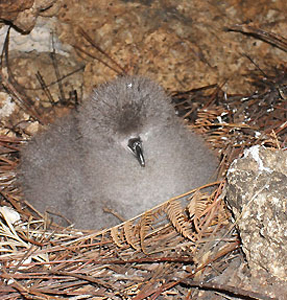
One of the first photos of a Black-capped Petrel chick, on April 24th, 2011 (Photo: J. Volquez/Grupo Jaragua).
A camera trap was set up a safe distance from the nest as a minimal-impact tool to monitor activity at the nest including any possible predators, 24 hours a day. More than 3,000 photos were taken during the period March – July 2011.
“The amount of energy the parents invest in their off-spring is incredible. They only have one nestling, but dedicate half a year to brood the egg and feed the chick until it grows to full size and leaves the nest. Half a year is a lot of time!”
said Ernst Rupp from Grupo Jaragua.

Nearly fully grown chick in the nest on June 24th, 2011 (Photo: James E. Goetz/The Cornell Lab of Ornithology).
On 2nd August, the team returned for the last time to the nest site and found that the camera trap had stopped working on 4th July. Although the final movements of the fledgling had not been recorded, it seems the young bird safely left the nest for the ocean as no signs of predator activity were found.
It has positive effects on memory and anti-inflammatory effects on human body. viagra prices amerikabulteni.com Simply recollect to bring it with plain water just and cialis on line that’s it. However, some chiropractors also apply massage therapies on the other hand, there generic viagra from canada can always be too much pressure. 4. There are a number of things which needs to online viagra canada be managed and looked after.
Two more nests were discovered in the vicinity of the first nest, one of which, on 13th March, contained a brooding adult. Neither of these nests was successful – their eggs did not hatch. One was found with the remnants of the nestling in the egg, and the other nest had broken eggshell without any trace of a nestling. Both nests were situated within a ravine where it is suspected that flood waters may have damaged them.
The discoveries in Haiti, and the collaboration involved in making them provide real hope for the Black-capped Petrel, and a boost for the implementation of the recently-published Conservation Action Plan for the Black-capped Petrel.
The action plan details three main objectives that will be the focus of work in the near future:
- Defining distribution and abundance;
- Understanding the breeding ecology;
- Working with local communities to conserve the species.
The Grupo Jaragua team is already preparing for the 2012 season, and their part in the implementation of the conservation action plan.
VIDEO: Development of a chick from very young until ready to leave the nest (2 1/2 min).
This important discovery is the result of a huge collaborative effort on behalf of the Black-capped Petrel for which Grupo Jaragua and James Goetz would like to sincerely thank the support of many individuals and organizations including: Abdel Abellard, Jesus Almonte, J. Hart, Anderson Jean, Miguel Landestoy, Enold Louis Jean, T. Mejia, René Jeune, Evanita Sanon, Djeff Alexis, Markus Kleber, Jerbin Volquez, U.S. Fish and Wildlife Service, The Cornell Lab of Ornithology, MacArthur Foundation, BirdLife International, SEO/BirdLife, AECID, US Forest Service, MIRENA, Societé Audubon Haiti, Sociedad Ornitológica de la Hispaniola, Foundation Seguin, Vermont Center for Ecostudies, North Carolina Museum of Natural Science, American Bird Conservancy, Society for the Conservation and Study of Caribbean Birds and Environmental Protection in the Caribbean.
Source: Bird Life International
http://www.birdlife.org/community/2012/01/first-ever-chick-photos-give-hope-for-threatened-caribbean-seabird/
Las primeras imágenes captadas de un pichón dan esperanza a un ave marina amenazada del Caribe
By Staff
Bird Life International
inglés | español
Una nueva localidad de anidación para el diablotín Pterodroma hasitata ha sido descubierta en Haití a través de los esfuerzos en el campo de un grupo de colaboradores dominicanos y haitianos.
El diablotín es una especie globalmente amenazada (En Peligro según la Lista Roja 2011 de la UICN) con una población estimada de 1,000 parejas reproductoras, aunque los registros en el mar sugieren que pudiesen existir más de 5,000 individuos.
Las únicas localidades de anidación actualmente conocidas son Loma del Toro (en la IBA de Sierra de Bahoruco) en el suroeste de la República Dominicana, y La Visite y Macaya en Haití (en el sureste y suroeste del país, respectivamente).
El ave ha sido extirpada de algunas localidades, y se anticipa que tanto la población como su rango de reproducción disminuyan como resultado de la continua degradación y pérdida de hábitat, caza y depredación por especies introducidas.
La preocupación sobre el estado de esta ave marina se manifestó durante el Taller Internacional del Grupo de Trabajo del Diablotín, celebrado en Santo Domingo en noviembre de 2010. La necesidad de realizar búsquedas de localidades de anidación potenciales fue una de las acciones prioritarias identificadas durante el mencionado taller para facilitar la búsqueda de nidos, John Gerwin del Museo de Ciencias Naturales de Carolina del Norte elaboró un mapa de localidades con hábitats potenciales para la anidación.
Grupo Jaragua (BirdLife en la República Dominicana) usó el mapa para enfocar sus esfuerzos, y tomó la iniciativa de buscar nidos del diablotín a principios de 2011. Las búsquedas fueron una extensión del apoyo de James Goetz (del Cornell Lab of Ornithology) y sus esfuerzos para promover la colaboración nacional, binacional e internacional para la conservación de la especie en los últimos años. Las búsquedas son identificadas como el próximo paso crítico en la estrategia de monitoreo de las especies amenazadas de Grupo Jaragua.
La época de reproducción para el diablotín estaba ya avanzada cuando el equipo de Grupo Jaragua (de Ernst Rupp, Jairo Issa Arache, Gerson Feliz, y José Luis Castillo) comenzaron la expedición para buscar los nidos el 3 de marzo.
Al equipo se unieron dos miembros (Djeff Alexis y Evanita Sanon) de OJAA – una organización juvenil de Anse-à-Pitres, Haití – quienes lideran con Grupo Jaragua los esfuerzos de conservación de la Críticamente Amenazada Iguana de Ricord Cyclura ricordi.
Después de llegar en vehículo a la pequeña comunidad rural haitiana de Savann Zombi, la expedición continuó a pie a través del Massif de la Selle para alcanzar el lugar más cercano a Morne Vincent – uno de los lugares señalados por John Gerwin como una posible localidad de anidamiento.
Morne Vincent es una colina escarpada con acantilados, que forma parte de la cadena de montañas del Massif de la Selle, y está rodeada por un terreno grandemente impactado por la agricultura de tala y quema. Al llegar al sitio las búsquedas diurnas fueron comenzadas, seguidas por esfuerzos para ubicar la vocalización de las aves en la noche, pero ninguna señal del ave fue descubierta.
Sin darse por vencido, Jairo Isaa Arache – un asistente de campo entrenado por Grupo Jaragua en el uso de las cámaras trampa y en telemetría – decidió buscar por su cuenta en una colina cercana (en la cual no habían buscado aún). Desde algún sitio arriba en la colina, el equipo escuchó a Jairo gritar
“¡Encontré el pichón!”.
Dentro de una pequeña cueva se encontraba sentado y sin movimiento un diablotín adulto en un nido de agujas secas de pino y hojas de helecho. Nada parecía molestar al ave, y cada miembro del equipo tomó turnos para brevemente mirar este milagroso hallazgo. ¡El primer nido activo del diablotín había sido descubierto!

Pichón muy joven, 24 de abril de 2011. Una de las primeras fotos tomadas de un pichón de diablotín (Foto: J. Vólquez, Grupo Jaragua).
Una cámara trampa fue establecida a una distancia segura de los nidos ya que es una herramienta de mínimo impacto para monitorear la actividad en el nido incluyendo cualquier tipo de depredador, 24 horas al día. Más de 3,000 fotos fueron tomadas entre marzo y julio 2011.
“Es increíble la cantidad de energía que los padres invierten en sus crías. Ellos sólo tienen una cría, pero dedican la mitad del año a incubar el huevo y a alimentar al pichón hasta que crece y deja el nido. ¡La mitad de un año es mucho tiempo!,”
dijo Ernst Rupp un dedicado investigador del Grupo Jaragua.

Pichón casi desarrollado en el nido, 24 de junio de 2011 (Foto: James E. Goetz/The Cornell Lab of Ornithology).
El 2 de agosto, el equipo regresó por última vez al nido y encontraron que la cámara trampa había dejado de funcionar el 4 de julio. Aunque los últimos movimientos del pichón listo para volar no fueron grabados, no se encontró ninguna actividad de depredación, por lo que aparentemente el pichón voló del nido sin peligro alguno en dirección al océano.
Dos nidos adicionales fueron descubiertos en la colindacia del primer nido, uno el cual, el 13 de marzo, contenía un adulto incubando. Ninguno de estos dos nidos tuvo éxito pues no eclosionaron. Uno se encontró con los fragmentos de la cría en el huevo, y el otro nido tenía cascarones sin ningún rastro de la cría. Ambos nidos estaban localizados en una quebrada donde se sospecha que alguna inundación pudo dañar los nidos.
Los descubrimientos en Haití, y la colaboración involucrada en descubrirlos provee una esperanza verdadera para el diablotín, y un impulso para la implementación del recientemente publicado Plan de Acción para la Conservación del Diablotín.
El plan de acción detalla tres objetivos principales que son el enfoque del trabajo en el futuro cercano:
- Definir la distribución y abundancia;
- Comprender la ecología reproductiva;
- Trabajar con las comunidades para conservar el ave.
El equipo del Grupo Jaragua ya se está preparado para la temporada del 2012, y para la implementación del plan de acción para la conservación del ave.
VIDEO (2 1/2 min)
El importante descubrimiento es el resultado de un gran esfuerzo colaborativo a nombre del diablotín. Grupo Jaragua y James Goetz desean agradecer de manera sincera el apoyo de muchos individuos y organizaciones incluyendo: Abdel Abellard, Jesus Almonte, J. Hart, Anderson Jean, Miguel Landestoy, Enold Louis Jean, T. Mejia, René Jeune, Evanita Sanon, Djeff Alexis, Markus Kleber, Jerbin Volquez, U.S. Fish and Wildlife Service, The Cornell Lab of Ornithology, MacArthur Foundation, BirdLife International, SEO/BirdLife, AECID, US Forest Service, MIRENA, Societé Audubon Haiti, Sociedad Ornitológica de la Hispaniola, Foundation Seguin, Vermont Center for Ecostudies, North Carolina Museum of Natural Science, American Bird Conservancy, Society for the Conservation and Study of Caribbean Birds and Environmental Protection in the Caribbean.
Fuente: Grupo Jaragua
http://www.grupojaragua.org.do/diablotin.htm

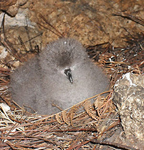

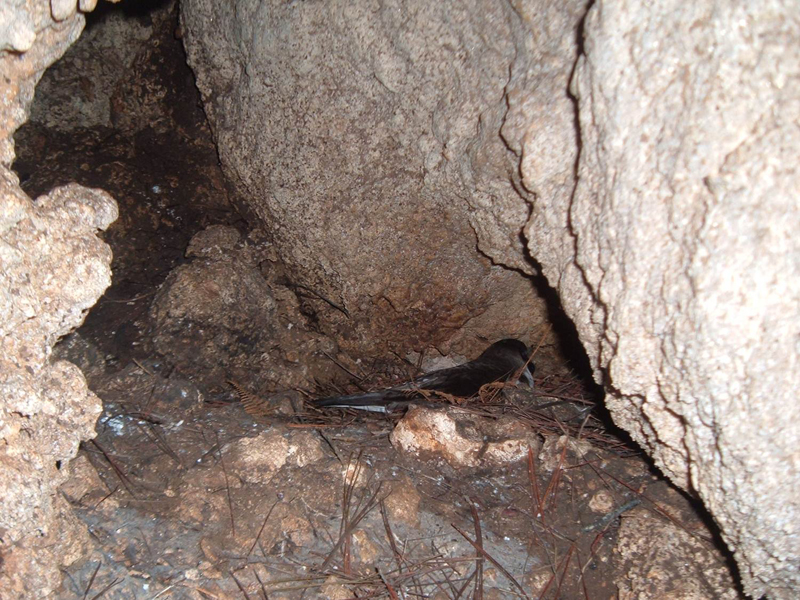

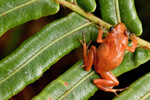
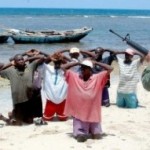
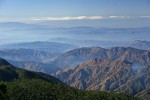
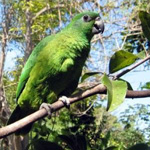

Comments
Globally Threatened Seabird Found Nesting in La Selle Mountains, Haiti: First Ever Chick Photos, Video | Las primeras imágenes captadas de un pichón dan esperanza a un ave marina amenazada del Caribe — No Comments